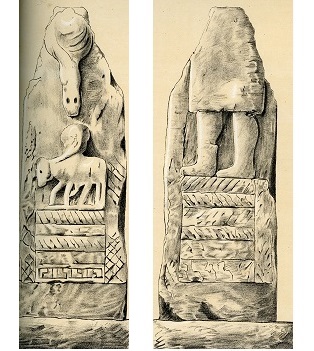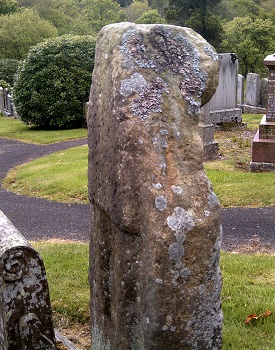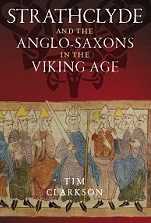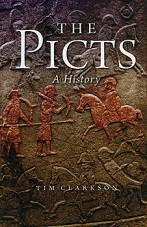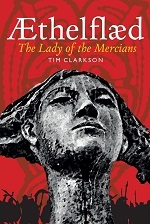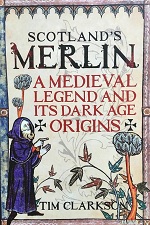
The Barochan Cross (Copyright © Brian McGuire)
The Barochan Cross is one of the oldest surviving examples of the ‘Govan School’ sculptural style. Since 1981 it has been displayed in Paisley Abbey, in the south-west corner of the nave, where its carvings can be admired by visitors. Unfortunately, this magnificent monument was exposed to the elements for more than a thousand years and much of its detail has weathered away. It nonetheless holds a place in the first rank of free-standing crosses from early medieval Scotland. Moreover, it is one of only two intact crosses from the kingdom of Strathclyde (the other being the Netherton Cross at Hamilton) and has rightly been described by archaeologist Derek Alexander as ‘definitely the finest cross of the Govan School’.
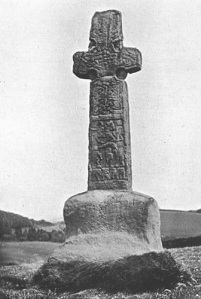
The Barochan Cross in its secondary position on Corslie Hill (click on image to enlarge)
The cross is 2.6 metres tall and formerly stood almost a metre higher on its original base, from which it is now sundered by a distance of 6 miles. The base or socket-stone still stands
in situ on Corslie Hill in Renfrewshire, and should (in my view) be reunited with the cross. Both are integral parts of a single monument which is incomplete while they remain separated. Like the sculptured stones in Govan Old Parish Church, the cross was carved from the local sandstone of the Glasgow area. It exhibits the same elaborate designs we see on the Govan Sarcophagus and is probably of similar date, both monuments originating in the early phase of the Govan School when the standard of craftsmanship was very high. Both may have been carved in the 9th century, with the cross perhaps being the older of the two.
The carvings on the cross include a number of features characteristic of the Govan School: a horseman holding a spear, a pair of animals, key-patterns and double-beaded interlace. A drawing by John Romilly Allen, published in 1903, allows us to examine the carvings in some detail, despite the damage inflicted upon them by the weather.

J.R. Allen’s drawing of the Barochan Cross, published in 1903 (click on image to enlarge)
: A ring can be seen emerging from the four ‘armpits’. Double-beaded interlace extends across the arms to form a knot in the centre of the head. The same decoration seems to be on both sides (as far as I can tell) and on the ends of each horizontal arm. The undersides of the arms are decorated with small key-patterns similar to swastikas. Although the topmost section appears to be blank it does in fact contain defaced or badly weathered carvings, presumably of interlace.
Cross-shaft: On one side, the upper panel shows four robed figures beneath double-beaded interlace. The lower panel shows four hornblowers, armed with spears, marching from left to right above more interlace. On the other side, a panel of interlace forms the lower portion of the cross-head. Below is a panel containing three elements: a spear-armed rider facing an unmounted figure; a figure with an axe facing another with arm raised (holding a weapon?) while a smaller figure stands in between; and, at the bottom, two animals with open jaws face one another. Narrow panels of interlace and key-pattern run down the sides of the shaft.
What do these designs represent, and what was the purpose of the monument?
Local tradition formerly associated the cross with the Battle of Renfrew (1164) where an army of Scots led by High Steward Walter fitz Alan (ancestor of the Stewart dynasty) defeated the forces of Somerled, Lord of the Isles. We now know that the cross pre-dates the battle by 300 years, long before the Lordship of the Isles was founded by Somerled’s Viking forefathers. In any case, Walter commissioned a commemorative monument of his own to mark the site of his victory. This was not a cross but an eight-sided pillar which survived until the late 18th century.
The first and most obvious observation about the Barochan Cross is that it was not originally associated with a religious site. Before being placed on Corslie Hill in the 1850s it stood in a less-elevated position near a crossroads where the Barochan Road comes up from the village of Houston before continuing north towards the River Clyde. At the crossroads this old road meets another running west to the ancient church of St Fillan’s at Kilallan. Although the northern route now veers north-west towards Langbank its older line must surely have continued to the ancient ford near West Ferry. Here, on the southern bank opposite Dumbuck, lay the lowest fording-point on the river before the main channel was deepened in modern times.

The original site of the Barochan Cross in its geographical context (click on image to enlarge)
To early medieval travellers the road from Houston would have been a direct route to the royal fortress of the Clyde Britons on Dumbarton Rock, a mile west of Dumbuck. It seems likely that the Barochan Cross was placed on this road at an important junction where it crossed the route to St Fillan’s Church at Kilallan. Above, on the summit of Corslie Hill, lay an Iron Age settlement enclosed by two circles of earthworks. Although presumably long-abandoned by c.800, this defended residence or hillfort would have retained an aura of ancient power. Likewise, the decaying turf ramparts of a small Roman fort on Barochan Hill would also have been visible in the early medieval landscape. The Roman site apparently bore the name
Coria which in Brittonic means ‘place of assembly’, especially in the context of gathering an army. We can infer that the Romans borrowed this name from a place formerly used by the local Britons, the Dumnonii or Damnonii, as a muster-point for warriors. It is tempting to identify the original
coria as the Iron Age settlement on Corslie Hill. Both this and its Roman neighbour may have influenced the choice of location for the later cross, whose warlike imagery would not have seemed out of place in such a setting. It is worth noting that the Fleming family, who held land at Barochan in medieval times, built their own centre of power – a small castle – on the summit of Corslie Hill.

The Barochan Cross in John Stuart’s ‘Sculptured Stones of Scotland’ of 1856 (click on image to enlarge)
Apart from the obvious fact that it is a Christian symbol, nothing in the carvings on the Barochan Cross suggests that it served a religious purpose. The imagery is secular rather than ecclesiastical. Thus, even if the four robed figures might be priests or monks, we must conclude that the monument as a whole was commissioned by a secular elite whose particular interests it vividly displayed. By analogy with similarly ornate free-standing crosses elsewhere in Scotland we could go further by suggesting that these patrons were people of royal status. Given its original location, only 12 miles from Govan and even closer to Dumbarton (
Dun Breatann, ‘Fortress of the Britons’), we can reasonably infer that the Barochan Cross was commissioned by the royal family of Strathclyde.

Renfrewshire and the Barochan Cross, with major secular and religious centres of the kingdom of Strathclyde.
The main panel of the cross, with its three elements or ‘registers’, seems to present a narrative or story that would have been familiar to people in the locality and to travellers passing north on their way to the ford. The image of a spear-armed rider facing an unmounted figure is reminiscent of the famous Pictish stone at Aberlemno in Angus, which describes (in three ‘registers’ telling a single narrative) a battle between horsemen and infantrymen. Pictish sculptural art had a major influence on the Govan School so it would not be surprising to find this type of martial imagery in Renfrewshire. One of the three figures in the middle of the Barochan panel holds an axe and is presumably a warrior, while the figure on the right might be blowing a trumpet during a battle, or drinking from a horn afterwards. The paired beasts below seem to be engaging in combat and might represent two opposing armies.

The main panel on the Barochan Cross

Warriors on the 8th century Pictish stone at Aberlemno (Copyright © B Keeling)
A tentative interpretation of the Barochan panel might see it as the celebration in stone of a famous victory gained by the Clyde Britons in the 9th century. If so, the battle in question need not have been fought in the immediate vicinity, nor indeed in the wider locality. It may be pushing a modern stereotype too far to suggest that the man with an axe is a Viking, one of the beasts is a wolf, and that the cross celebrates a military success over Scandinavian raiders in the Firth of Clyde, but the date and location would conveniently fit this context. I sometimes wonder if the four hornblowers or trumpeters on the other side might depict the Old Testament story of Joshua’s Israelites destroying the walls of Jericho, but perhaps they are simply the victorious Britons sounding a note of triumph across the firthlands of their kingdom.
* * * * * * *
References:
Derek Alexander & Gordon McCrae (2012) Renfrewshire: a Scottish county’s hidden past (Edinburgh: Birlinn) [the Barochan Cross is described on pp.88-9]
John Romilly Allen and Joseph Anderson (1903) The Early Christian monuments of Scotland (Edinburgh: Society of Antiquaries of Scotland) [pp.455-7 of Part III] Reprinted in facsimile by the Pinkfoot Press in 1993 and still available from them (as is their excellent guide to the Govan stones).
Alan Macquarrie (2006) Crosses and upright monuments in Strathclyde: typology, dating and purpose. The 2005 Govan Lecture (Govan: Society of Friends of Govan Old)
I am grateful to Brian McGuire, founder of the community website Paisley.org.uk, for allowing me to use his photograph of the Barochan Cross.
Relevant links:
The Barochan Cross at Paisley Abbey
Nigel Cole’s video of the Barochan Cross
Those of you who are on Twitter may be interested in following these accounts:
The Govan Stones @GovanStones
Paisley.org.uk @paisleyorguk
Brian McGuire @brianmcgui
Me @EarlyScotland
* * * * * * *
Read Full Post »
